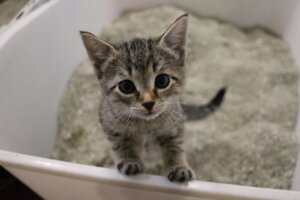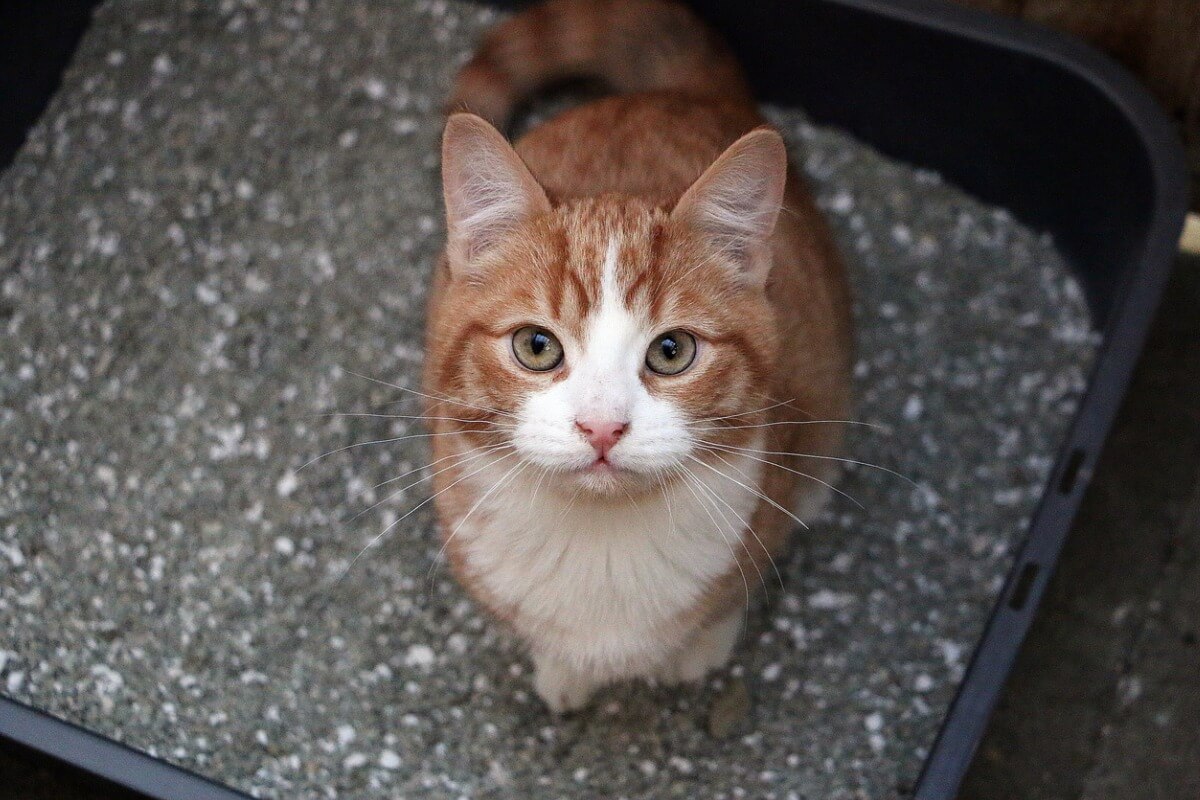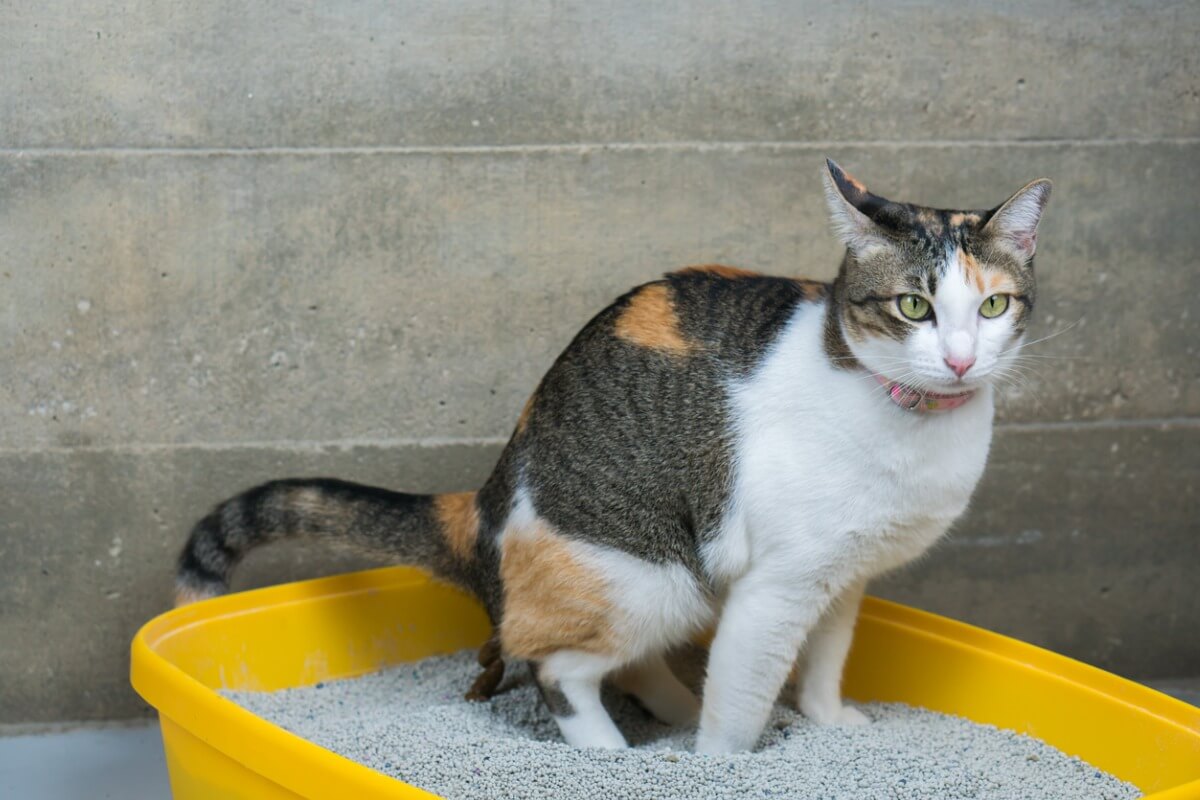How Often Should Your Cat's Litter Be Changed?


Reviewed and approved by the biologist Samuel Sanchez
The litter box is an essential part of your cat’s life. The handling that you give to this element can contribute to maintaining the hygiene of the companion animal and even impact its behavior. Therefore, it’s important to be clear about when you need to change your cat’s litter, how to clean its litter box, and even where to place it.
In the same way, you need to know what type of litter you’re using for your pet to relieve itself, as not all of them work in the same way. Ideally, the cat should feel comfortable, but neither should it suffer from any allergic reaction from contact with the materials in its litter box. The following article will guide you through this important topic.
The importance of litter boxes for cats
Cleanliness is a very important aspect of a cat’s life, so maintaining good hygiene of their litter tray isn’t something you should ignore. Those who have a cat at home should learn when to change the cat’s litter, what type of material to use, and how much is appropriate for the tray they relieve themselves in.
In general, cats learn to use their litter box from a very young age. For this reason, this tray must always have good hygiene conditions. Otherwise, your pet may become ill, develop behavioral disorders, or relieve themselves elsewhere.
In addition to the above, constantly cleaning the cat’s litter box will help you keep track of the animal’s urine and feces. That is, you’ll be able to see how frequently your cat urinates and if it has diarrhea or any other problem regarding its stools. In addition, removing the feces from the sandbox daily will help prevent diseases such as toxoplasmosis.

How many litter boxes should a cat have?
It is recommended that each feline has two litter trays. As mentioned above, cats are demanding when it comes to grooming, so most prefer to have a litter box to urinate and another to defecate. Fortunately, this also makes cleaning the trays easier and provides better hygiene.
In addition, it should be noted that the ideal thing is for the litterboxes to be for their exclusive use. In other words, let only this cat use them. So, if you have several cats in your home, there must be different litter boxes for each of them. Also, the amount of substrate you put in the boxes should be enough but not exaggerated, just enough for your cat to bury its feces.
Types of cat litter
Currently, there are different cat litters on the market and it’s important that you learn to identify each of them. The type of sand also determines the frequency in which it changes, understanding that not all them work in the same way.
In addition, it’s recommended that you have the opinion of a veterinarian when choosing the ideal litter for your cat. Some felines can be allergic to certain types of sand due to its composition. Below, we’ll show you the options your pet has regarding its sanitary substrate.
Absorbent sanitary sand
Although this sand is the cheapest, it doesn’t have a binding effect, which can be a drawback. In other words, non-agglomerated urine seeps throughout the litter box, making it easy to stain and harder to clean. As a result, this type of substrate will force you to remove your cat’s stools and urine more than once a day.
Clumping sand
Clumping sand is more expensive, but, contrary to the absorbent sanitary type, it turns the urine into small balls. In other words, it’s a more practical substrate because it compacts the waste and facilitates the cleaning of the sanitary tray.
Sand in pearls or crystals
Pearl or crystal sand is very expensive and is made up of silica. This type of sand is absorbent but also binds and it can eliminate bad odors. It’s a white sand that turns yellow on contact with urine, which allows you to easily identify when to remove the cat’s stools. Although it’s very practical, some cats won’t put up with it.
Ecological sand
This type of sand isn’t only the most expensive, but also the most innovative, as it’s composed of vegetable fibers, in addition to having a binding effect. However, it can stick to your pet’s legs and tail and its smell tends to cause some cats to reject it.
When to change the cat litter?
Changing cat litter depends on how dirty it is, so there’s no exact answer to this question. However, it’s advisable to collect your pet’s stools daily, regardless of the type of litter you use.
In general, if it’s non-agglomerated sand, it’s advisable to change it 1 to 2 times a week. On the other hand, in the case of agglomerates, the change can occur once a month, but always depending on how dirty the box is. Remember that cats usually choose to relieve themselves outside the litter tray if it isn’t hygienic.
Cleaning the sandbox
The complete cleaning of the litter tray is also essential for the comfort and well-being of your feline pet, especially if your cat uses absorbent litter, because urine can easily leak throughout the litter box. When completely changing the substrate, it’s best to wash the box or tray with warm water and use a mild soap that your pet won’t hate.
Finally, keep in mind that the sandbox also wears out, so as soon as you start to see it deteriorate, it’ll need to be changed. Now, if, in the same way, you consider varying the type of sand that your pet uses, you must be very careful about it. Remember that any change in your cat’s routine can cause stress.
According to what we’ve shared with you, you can choose to gradually incorporate the new litter into the litter tray with the litter that your cat was already used to using. When the cat accepts it without any problems, then you can reward it.

In conclusion, your cat should always have a hygienic litter box that’s located in a safe place. It also needs to feel comfortable when it comes to going to the toilet, and its litter tray shouldn’t pose any risk to its health.
The litter box is an essential part of your cat’s life. The handling that you give to this element can contribute to maintaining the hygiene of the companion animal and even impact its behavior. Therefore, it’s important to be clear about when you need to change your cat’s litter, how to clean its litter box, and even where to place it.
In the same way, you need to know what type of litter you’re using for your pet to relieve itself, as not all of them work in the same way. Ideally, the cat should feel comfortable, but neither should it suffer from any allergic reaction from contact with the materials in its litter box. The following article will guide you through this important topic.
The importance of litter boxes for cats
Cleanliness is a very important aspect of a cat’s life, so maintaining good hygiene of their litter tray isn’t something you should ignore. Those who have a cat at home should learn when to change the cat’s litter, what type of material to use, and how much is appropriate for the tray they relieve themselves in.
In general, cats learn to use their litter box from a very young age. For this reason, this tray must always have good hygiene conditions. Otherwise, your pet may become ill, develop behavioral disorders, or relieve themselves elsewhere.
In addition to the above, constantly cleaning the cat’s litter box will help you keep track of the animal’s urine and feces. That is, you’ll be able to see how frequently your cat urinates and if it has diarrhea or any other problem regarding its stools. In addition, removing the feces from the sandbox daily will help prevent diseases such as toxoplasmosis.

How many litter boxes should a cat have?
It is recommended that each feline has two litter trays. As mentioned above, cats are demanding when it comes to grooming, so most prefer to have a litter box to urinate and another to defecate. Fortunately, this also makes cleaning the trays easier and provides better hygiene.
In addition, it should be noted that the ideal thing is for the litterboxes to be for their exclusive use. In other words, let only this cat use them. So, if you have several cats in your home, there must be different litter boxes for each of them. Also, the amount of substrate you put in the boxes should be enough but not exaggerated, just enough for your cat to bury its feces.
Types of cat litter
Currently, there are different cat litters on the market and it’s important that you learn to identify each of them. The type of sand also determines the frequency in which it changes, understanding that not all them work in the same way.
In addition, it’s recommended that you have the opinion of a veterinarian when choosing the ideal litter for your cat. Some felines can be allergic to certain types of sand due to its composition. Below, we’ll show you the options your pet has regarding its sanitary substrate.
Absorbent sanitary sand
Although this sand is the cheapest, it doesn’t have a binding effect, which can be a drawback. In other words, non-agglomerated urine seeps throughout the litter box, making it easy to stain and harder to clean. As a result, this type of substrate will force you to remove your cat’s stools and urine more than once a day.
Clumping sand
Clumping sand is more expensive, but, contrary to the absorbent sanitary type, it turns the urine into small balls. In other words, it’s a more practical substrate because it compacts the waste and facilitates the cleaning of the sanitary tray.
Sand in pearls or crystals
Pearl or crystal sand is very expensive and is made up of silica. This type of sand is absorbent but also binds and it can eliminate bad odors. It’s a white sand that turns yellow on contact with urine, which allows you to easily identify when to remove the cat’s stools. Although it’s very practical, some cats won’t put up with it.
Ecological sand
This type of sand isn’t only the most expensive, but also the most innovative, as it’s composed of vegetable fibers, in addition to having a binding effect. However, it can stick to your pet’s legs and tail and its smell tends to cause some cats to reject it.
When to change the cat litter?
Changing cat litter depends on how dirty it is, so there’s no exact answer to this question. However, it’s advisable to collect your pet’s stools daily, regardless of the type of litter you use.
In general, if it’s non-agglomerated sand, it’s advisable to change it 1 to 2 times a week. On the other hand, in the case of agglomerates, the change can occur once a month, but always depending on how dirty the box is. Remember that cats usually choose to relieve themselves outside the litter tray if it isn’t hygienic.
Cleaning the sandbox
The complete cleaning of the litter tray is also essential for the comfort and well-being of your feline pet, especially if your cat uses absorbent litter, because urine can easily leak throughout the litter box. When completely changing the substrate, it’s best to wash the box or tray with warm water and use a mild soap that your pet won’t hate.
Finally, keep in mind that the sandbox also wears out, so as soon as you start to see it deteriorate, it’ll need to be changed. Now, if, in the same way, you consider varying the type of sand that your pet uses, you must be very careful about it. Remember that any change in your cat’s routine can cause stress.
According to what we’ve shared with you, you can choose to gradually incorporate the new litter into the litter tray with the litter that your cat was already used to using. When the cat accepts it without any problems, then you can reward it.

In conclusion, your cat should always have a hygienic litter box that’s located in a safe place. It also needs to feel comfortable when it comes to going to the toilet, and its litter tray shouldn’t pose any risk to its health.
All cited sources were thoroughly reviewed by our team to ensure their quality, reliability, currency, and validity. The bibliography of this article was considered reliable and of academic or scientific accuracy.
- Preguntas y respuestas relativas a los gatos. Asociación de Veterinarios Españoles Especialistas en Pequeños Animales. Recogido el 1 de septiembre de 2021 de: https://www.avepa.org/pdf/ASOCIACIONES%20INTERNACIONALES/Preguntas%20y%20Respuestas%20relativas%20a%20los%20gatos.pdf
- Comportamiento felino, instrucciones especiales de cuidado. MSD Animal Health. Recogido el 1 de septiembre de 2021 de: https://aragohv.com/wp-content/uploads/2019/06/comportamientofelino.pdf
This text is provided for informational purposes only and does not replace consultation with a professional. If in doubt, consult your specialist.








